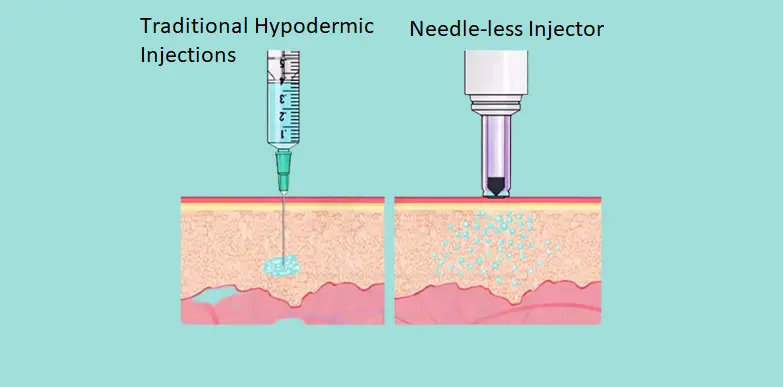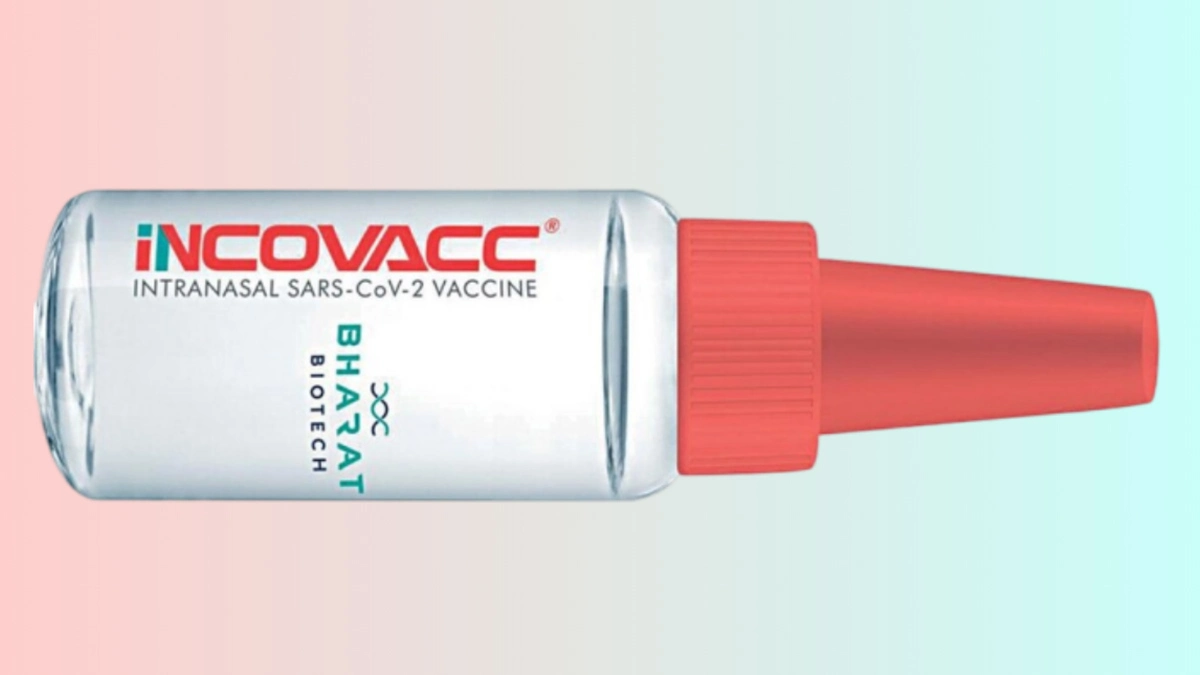Needle free Injections, traditional hypodermic injection, Advantages of needle-free injection, Disadvantages of needle-free injection, intranasal vaccine, COVID-19 vaccine Bharat Biotech, iNCOVACC, ICMR research, contaminated needles.

Which Is Better, Needle-Free Injection or Needle Injection?
Needle-free injection technology has been around for decades, but it has only recently begun to gain widespread use in the medical community. This is due in part to advances in the technology, which have made needle-free injections more effective and less expensive.
But which is better: needle-free injection or needle injection?
Here is a detailed comparison of the two methods:
Needle-free injection
Needle-free injection uses a high-pressure jet to deliver medication through the skin. This method is painless and virtually bloodless. It is also very fast, with injections typically taking less than a second to complete.
Needle-free injection can be used to deliver a wide range of medications, including vaccines, insulin, and other biologics. It is also being investigated for use in the delivery of gene therapies and other novel treatments.
Advantages of needle-free injection
- Painless
- Virtually bloodless
- Very fast
- Can be used to deliver a wide range of medications
- Easier to administer for both patients and healthcare workers
Disadvantages of needle-free injection
- Can be more expensive than needle injection
- May not be as effective for delivering certain medications
- May not be suitable for all patients
Needle injection
Needle injection is the traditional method of delivering medication into the body. It involves using a needle and syringe to pierce the skin and inject the medication into the muscle or bloodstream.
Needle injection is a very effective way to deliver medication, but it can be painful and cause anxiety for some patients. It is also important to note that needle injection carries a small risk of side effects, such as infection, bleeding, and nerve damage.
Advantages of needle injection
- Less expensive than needle-free injection
- More effective for delivering certain medications
- More suitable for all patients
Disadvantages of needle injection
- Painful
- Can cause anxiety
- Carries a small risk of side effects
Which is better?

So, which is better: needle-free injection or needle injection?
The answer depends on a number of factors, including the type of medication being administered, the patient’s preferences, and the cost.
In general, needle-free injection is a good option for patients who are afraid of needles or who experience pain or anxiety with needle injections. It is also a good option for patients who need to receive multiple injections or who need injections of medications that are difficult to deliver with a needle and syringe.
However, needle injection is still the preferred method of delivering certain medications, such as those that need to be injected into the muscle or bloodstream. Needle injection is also more cost-effective than needle-free injection.
Needle-Free Injections vs Traditional Needles: Which is Better for ? ICMR’s Case Study
Needles have long been a source of fear and discomfort for many when it comes to receiving vaccinations or essential injections. The pain and anxiety associated with needles can make the experience daunting. Moreover, traditional needles can break the skin’s protective barrier, potentially exposing individuals to infectious diseases like HIV, which can spread through contaminated needles.
In response to these concerns, the Indian Council of Medical Research (ICMR) undertook a pioneering study to evaluate the effectiveness of needle-free injection systems compared to traditional needle injections for delivering the ZyCoV-D vaccine against SARS-CoV-2.
Key Findings of the ICMR Study
The study aimed to make vaccinations less intimidating by exploring the potential of needle-free systems. Researchers at ICMR conducted experiments on 20 monkeys, dividing them into five groups. Four of these groups received different doses of the ZyCoV-D vaccine through the new needle-free system, while the fifth group received a saline solution instead of the vaccine. The monkeys received their injections on three separate occasions and were exposed to the COVID-19 virus 15 weeks later. Blood and other samples were collected to analyze their immune responses.
The results were striking. The group that received the highest vaccine dose through the needle-free system exhibited the most robust immune response. These monkeys developed strong antibodies and had fewer virus particles in their bodies after exposure to the virus.
Based on these findings, ICMR hypothesized that needle-free vaccines have the potential to revolutionize immunization technology, offering enhanced immune responses and better viral clearance.
The Promise of a COVID-19 Nasal Vaccine

ICMR’s study is part of India’s ongoing efforts to explore needle-free immunization systems. Notably, India made significant progress in the fight against the COVID-19 pandemic with the introduction of iNCOVACC, a novel intranasal vaccine developed by Bharat Biotech. This vaccine, which was hailed as a game-changer, eliminates the need for needles and pain during administration. Instead, it is delivered as drops through the nose.
iNCOVACC, developed using technology licensed from the Washington University School of Medicine, marked a historic milestone as the world’s first nasal vaccine administered as drops.
Needle Free Injection
ICMR’s recent study raises hopes for a groundbreaking development that could alleviate the fears and hesitations of millions of people in India. Needle-free injection systems have the potential to significantly increase vaccination rates by eliminating the aversion to needles and reducing the risk of infections.

Moreover, if ICMR’s needle-free injection systems are similar to Bharat Biotech’s iNCOVACC, they may also reduce the reliance on healthcare workers’ expertise when administering vaccines, making the vaccination process more accessible and convenient for everyone.
Conclusion
ICMR’s research is a promising step towards a future where vaccinations are painless, efficient, and more widely accessible, ultimately contributing to the fight against infectious diseases like COVID-19. This breakthrough has the potential to transform immunization practices not only in India but around the world.
People also read :
- Elon Musk’s Neuralink gets FDA approval to implant chips in human brain
- Branded vs Generic Drugs: Understanding the Similarities and Differences
- New Regulations for Doctors: No Gifts from Pharma Companies
- 21 CFR guidelines for pharmaceuticals
- Top 10 most effective root cause analysis investigation tools
- ALCOA Plus 9 Principles for Data Integrity
Frequently Asked Questions
What is needle-free injection?
Needle-free injection is a method of delivering medication into the body without using a needle. A high-pressure jet is used to deliver the medication through the skin.
What is needle injection?
Needle injection is the traditional method of delivering medication into the body. It involves using a needle and syringe to pierce the skin and inject the medication into the muscle or bloodstream.
Which is better, needle-free injection or needle injection?
The best method depends on a number of factors, including the type of medication being administered, the patient’s preferences, and the cost. In general, needle-free injection is a good option for patients who are afraid of needles or who experience pain or anxiety with needle injections. Needle injection is still the preferred method of delivering certain medications, such as those that need to be injected into the muscle or bloodstream.
What are the advantages of needle-free injection?
Needle-free injection is painless, virtually bloodless, and very fast. It can also be used to deliver a wide range of medications.
What are the disadvantages of needle-free injection?
Needle-free injection can be more expensive than needle injection, and it may not be as effective for delivering certain medications. It may also not be suitable for all patients.
Pain relief shower soap 🧼 ( headache)